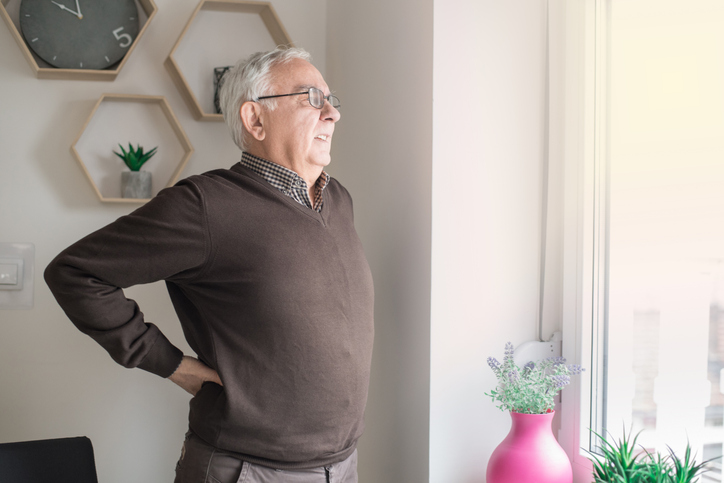
Being a carer can be a heavy load to bear.
Without proper care, the heavy lifting, bending, and turning can wreak havoc on your back, neck, and shoulders.
In Australia, while most workplaces have stringent OH&S policies and procedures in place to protect worker health and safety, very few carers have this luxury since the majority of work takes place informally.
In the absence of such processes, carers face a very real threat of injury. This can impact your ability to continue in your caregiver role.
We’ve got your back with our carer’s guide to spinal health.
Set the scene
Preparation is key to protecting your spinal health. If you are about to move your loved one, first ensure the room is free from clutter or tripping hazards. Make sure you have all the necessary equipment and tools at hand. If you are moving them into a wheelchair, make sure the chair is close by and the wheels are locked.
Communication is also a key part of setting the scene. Caring is a symbiotic partnership. While your loved one needs your help to move and perform day-to-day tasks, you need them to be motivated and to assist wherever possible.
If you need to move them, be clear about what you are going to do, even if they don’t seem fully aware. If they seem hesitant or unmotivated, try to find ways to encourage them. If you are working in opposition to each other, you increase both of your chances of sustaining an injury.
Remember to check if they are sore, or suffering pain anywhere. If so, avoid these areas as much as possible.
Use the right technique
The most common cause of back, neck, and shoulder injuries is repetitive movement. Doing the same thing over and over again.
Caring often involves repetitive movements such as helping someone into a wheelchair, helping them move from a reclining to a sitting position, helping them get in and out of bed, use the toilet, take a shower, or get dressed. It can also mean helping someone up who has had a fall.
Often the person may physically outweigh you, or they may lack the physical capability to provide much assistance. This can dramatically increase the load on your spine and put you at a higher risk of injury.
Here are some simple techniques you can use to avoid injury:
- Always lift using your legs, not your back. The muscles and bones in your legs are stronger than your back and can cope better with heavier weights. To lift with your legs, bend at your knees as if you were performing a squat. Keep your back straight and then use your leg muscles to stand up straight.
- Keep your feet apart, with one foot slightly in front of the other. Keeping your feet staggered helps give you better balance.
- Work as a team. You are there to counteract their weaknesses. If you know their left side is weaker than their right, support more on that side. Count to three before you lift. This might seem silly, but counting helps build your own momentum and helps prepare your loved one to move.
- Stay close. Using your arms to hold someone’s weight puts a strain on the smaller muscles in your arm. Holding their weight close to your body requires less effort to move and uses your bigger muscle groups to stabilise the weight. Keep your feet in the direction you want to go and slowly lower them by bending your knees, not your back.
- Hold their hips, not their arms. Pulling or grabbing someone under their arms can cause extreme pain, as the muscles in the arms don’t handle force well.
- Stand straight – don’t twist. Twisting your torso or body dramatically reduces your core strength, meaning you will only be able to handle one-third of the weight as you would when standing still. If you need to change direction, wait until your loved one is standing straight, then use your feet and your whole body to turn in the direction you need to go.
- Take it slow. Be the turtle, not the hare. Slow and steady wins the race, and dramatically reduces your chances of injury.
Have the right tools and equipment
According to health and safety standards, the maximum weight one person can safely lift is 15kg, which is significantly lighter than the average person you will be caring for!
In addition to proper lifting techniques, there are many mobility tools and equipment that can help make the process safer and easier. These include hoists and lifts, transfer boards, movable showering chairs, grab bars, friction-reducing slip sheets, rollers, and other transfer aids.
An occupational therapist can advise you on special home modifications and tools that you can use, as well as show you how they can be used. Some of this equipment might be available for free, be subsidised by the government, or available through one of the non-government organisations. Call us on 03 6144 3729 for more information on what is available.
Stay fit, stay safe
While technique and tools can certainly help reduce your risk of injury, one of the best ways to prevent injury is to stay fit and healthy.
Remember being told to stand up straight and hold your head high in school? Well good posture is great for your overall health and fitness, and helps to protect your spinal health. And it’s not just when you’re standing. Good posture is just as important when you’re sitting or lying down as well.
Eating a healthy, well-balanced diet not only provides the fuel your body needs to get through a busy day of caring, it also helps to keep your body weight down, which in turn reduces the pressure on your spine and bones. Choose lots of fresh foods including fruit, vegetables, dairy and meats.
Staying fit also means getting regular exercise. Even something as simple as walking increases the blood flow to your back and leg muscles, making them stronger. If you want to increase your overall core strength, there are plenty of at-home exercises you can do. Even something as simple as bodyweight squats or deadlifts can help strengthen your back and core.
Helpful resources
Techniques for moving and handling people
Carer Gateway: Moving and lifting people safely
Manual Tasks guide for Carers








Thank you for the update and helpful resources. It is great to know you are still there and well, after such a long break with COVID19 restrictions. I am sure most of us Carers are quite used to restrictions and isolation, so it has not been too strange for us. Kind regards, Shirley